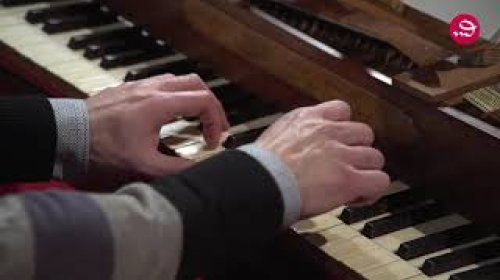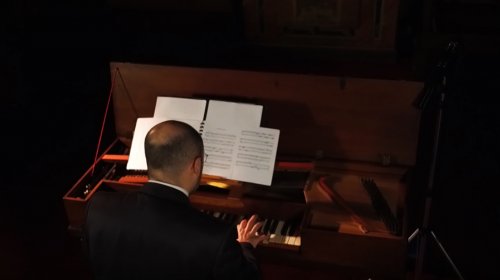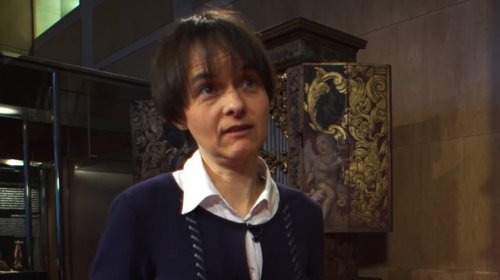Pablo Gómez Ábalos and Luca Guglielmi play the instrument after the restoraton


The restoration
During the last twenty years I often decided, together with the authorities of the various museums, against restoration. The square piano by Johannes Zumpe & Gabriel Buntebart from 1776 in the Museu de la Música in Barcelona was, in contrast, an instrument for which I embraced the idea of a restoration for musical use, after having examined it carefully in June 2015. The general condition of the instrument was very good, the case had not been distorted. The last restoration, probably done in the 1950s, before the instrument was sold to the museum, was not carried out with much care and knowledge. In particular the wood chosen for the replacement soundboard was of very bad quality. This square piano would not loose part of its originality by restoring it but, with a careful restoration, win back its original beauty and speech. It was a good example of where restoration can work at its best. In addition to the sound, interesting both for specialists and normal visitors, the instrument represents a testimonial for an important hammer action in the history of the piano.
BEFORE THE RESTORATION
For the realization of the project careful organological research was necessary. The square piano by
Zumpe & Buntebart from 1776 in the Museu de la Música in Barcelona has been changed over the centuries. To be able to reconstruct the original state of the instrument it was necessary to compare it with other pianos by Zumpe & Buntebart, to have as much information as possible about their construction principles.
The following square pianos by Johannes Zumpe & Gabriel Buntebart were examined:
Square piano Zumpe & Buntebart 1772, Museo degli Strumenti Musicali, Rome
Square piano Zumpe & Buntebart 1773, Museo degli Strumenti Musicali, Rome
Square piano Zumpe & Buntebart 1773, Rejksmuseum Amsterdam
Square piano Zumpe & Buntebart 1773, Händel-Haus Halle
Square piano Zumpe & Buntebart 1775, Museo degli Strumenti Musicali, Rome
Square piano Zumpe & Buntebart 1776, Museo degli Strumenti Musicali, Rome
Careful investigation of the Barcelona Zumpe & Buntebart piano and the comparison with the other above mentioned Zumpe & Buntebart pianos had revealed that the case and the inner construction are in original condition. The legs were probably built at the end of the 18th century. The action probably comes partly from another Zumpe piano and partly from another English square piano of the same period. The soundboard as well as some parts of the hammer action are presumably from the 1950s.
Before the restoration, an examination of the space underneath the soundboard (using an endoscope and a webcam) had highlighted a crack in the wrestplank over its entire length. To give the instrument its musical function back, it was necessary to take out the soundboard, to repair the crack in the wrestplank and to make a new soundboard with high quality wood.
THE RESTORATION IN DETAIL
Before beginning the restoration the string lengths were measured and a technical drawing in scale 1:1 of the bridge and nut position as well as the position of the wrest-pins was made.
The soundboard and the surrounding mouldings were not original. In comparison, the original soundboards in the Zumpe square pianos from 1773 in the Rejksmuseum Amsterdam and in the Händel-Haus in Halle have the characteristic writing of the notes in ink next to the wrestpins. The soundboard wood of the Zumpe piano in Barcelona had so few year rings that it was impossible to do an investigation with dendrochronology. Also, the wood had been attacked by woodworm infestation. The bridge and most of the wrest pins are original.
The removal of the soundboard was carried out using an adjustable steam generator with a small nozzle, important for accurate work. Without the soundboard one could see that the split in the wrestplank observed before the intervention was actually the upper layer of the wrestplank which had become unglued (the wrestplank is made of three layers). Because this upper layer had not only become unglued but was badly cracked long the line of the pins and worm-eaten, it was taken out and replaced by a new peace of beech wood. Of the second layer, also cracked long the pin lines and worm-eaten, a strip of around half the thickness was taken out and replaced with new wood
The belly rail which had become partly unglued was glued back and for more stability conical wooden pegs have been inserted. The base board, which had become unglued under the rear case wall, was glued back. In the base board underneath the keyboard there was a long opening with irregular edges. This opening was needed because at a certain point the instrument must have had a pedal board. Michael Cole explains in his article that the piano must have played for some time together with an organ. This is also confirmed by the small holes underneath the front of each key. The long opening in the baseboard as well as all cracks were closed with strips of new wood.
All the square pianos by Zumpe & Buntebart which have survived in their original state have a simple stand like the piano in the Rejksmuseum in Amsterdam. Also the instrument in the Museu de la Música in Barcelona would originally have had a stand of this type. The present four legs, made with good quality mahogany wood, are probably from the end of the 18th century, as already described above. They only needed some minor restoration work.
The hitch pin block was covered with a thick layer of shellac, not original, which was removed. Most of the iron pins in the nut, situated on the hitch pin block, were too large and surely not original. These pins had created cracks in the hitch pin block. They were removed, the holes were closed with wooden pegs and brass pins with diameters as measured in the Zumpe & Buntebart pianos in Amsterdam and Halle were inserted. In addition, the damaged and non-original part of the nut was replaced. The iron hitch pins are not original but have similar diameters to the originals. For that reason they were not taken out but reused to attach the new strings. However, the number of these pins exceeds the amount required for the strings (126 instead of 116 required). Those pins were chosen which guarantee that the strings would not obstruct the damper sticks passing through holes between the two strings.
The soundboard bridge is original but was split long the line of the bridge pins and because of past interventions, the height was lower than the original bridge. The cracks were closed as much as possible and where necessary, very fine strips of beech wood were inserted. The original height of the bridge was reconstructed as well as the original position of the bridge). The thicknesses for the new soundboard was measured in the Zumpe piano in Halle (3.0 – 3.5mm for the part behind the bellyrail to the wrestplank). The little blocks for the screws with which the bridge is fixed on to the soundboard were copied from the Zumpe piano in Rome. The mouldings around the soundboard were reconstructed copying the originals in the Zumpe & Buntebart pianos from 1773 in Amsterdam and Rome.
For the diameters of the new strings the advice of Michael Cole and Paul Poletti was followed. For reason of conservation slightly thinner diameters were chosen (bass octave with overwind strings, F# 0.56 brass – f3 0,335 iron). The diapason of note a1 = 430 Hertz was installed.
The frame on which the dampers are fixed is part of the back wall of the instrument, situated above the hitchpin block. It is made of two parts: on the lower part the dampers are glued and while on the upper part the springs are inserted (ill. 13). The upper part was in quite good condition whereas the lower part had been modified during the previous interventions. The original state of the damper frame was reconstructed following the surviving examples in the Zumpe & Buntebart pianos in Amsterdam, Halle and Rome.
The keyboard and hammer action frame is an original Zumpe frame but may come from another instrument of the same maker. That it is a genuine Zumpe frame is confirmed by the type of construction but also because of the particular way the green cloth was fixed on the back rail of the keyboard frame. The same type of green cloth was observed in various places in all the Zumpe pianos examined. The suspicion that the frame could belong to another instrument comes from the fact that it has been planed off in the treble to allow it to enter into the instrument.
In the period when the instrument had a pedal-board, an opening was not only cut into the baseboard but also into the front rail of the keyboard frame. Furthermore, the front rail had been raised up and square pieces of wood had been glued between the front rail and the balance rail. The whole keyboard frame was distorted. Because of the large opening in the front rail only little original fragments were left. During the restoration, a new front rail with the original height was installed and pieces of new wood were glued to the bottom of the original frame pieces to compensate for the distortion.
The keys of the Zumpe & Buntebart piano in Barcelona are not original but still very old. They probably come from another English square piano. The levers are slightly longer and made of spruce wood whereas the key levers of the surviving original Zumpe keyboards are all made of lime wood. The key covers of the naturals are very worn. They are thinner than the one observed in the other Zumpe square pianos. The keys were guided at the front, unlike Zumpes instruments which were guided in the back. On the other hand, there are also typical Zumpe characteristics like the mute GG# which is directly connected to the GG key, or the round cut-outs underneath the keys around the balance points. But both characteristics look more like being badly copied than being genuine.
The original guiding system at the back of the keys was reconstructed. For the guides ebony wood was used instead of the original whalebone material (the cartilage on the tongue of whales). The balance pin holes have been restored to guarantee precise movement without too much play. The lead weights were removed and the holes were closed with wood. Only the keys in the last treble octave needed small amounts of brass weights to be well balanced. At the back of the keys new pieces of oil tanned leather was glued on. The aim of the work was to reconstruct as light a keyboard as possible, with a touch as close as possible to the original.
The hammer frame, at a certain point in its history, seems to have had another register whose function remains unknown. Surely it was not an original Zumpe feature. Signs of this register were the rectangular openings cut into the side walls of the hammer frame and small trapezoidal blocks on the rail where the hammers rest. The openings in the side walls were closed during the restoration whereas the little blocks were left untouched.
Most of the hammers are original but they have been altered in the past. According to the ink numbers they are not in their original position any more. All hammers were covered with a thick and not original layer of shellac. During the past interventions the hammer shanks had been resized. They are slightly smaller in width and for some in length than they were originally. During those interventions, probably carried out in the 1950s, the little blocks underneath the hammer shanks were remade in a very inprecise way and with poor quality wood. The first three hammers in the bass were made in this period too. During the present restoration the layer of shellac was removed and the surface of the hammers was treated with linseed oil. All hammers were put back in order as well as possible using their ink numbers and every hammer was restored. The blocks underneath the hammer shanks were remade with mahogany wood and for the hinges fine strips of white alum tanned leather as observed in the Zumpe pianos in Amsterdam and Rome were glued in. Each hole was restored to ensure a precise movement of the hammer. The first three non-original hammers were rebuilt in mahogany wood. The leather of the hammer heads (the layer on the outside) is not original but could be from the end of the 18th or beginning of the 19th century. The analysis in a chemical laboratory in Tuscany revealed leather made of skin from hybrid animals half goat half sheep, tanned with vegetables.
The damper mechanism had been changed in the past. As already described above, the rail on which the dampers are fixed had been modified, as well as the way the dampers moved. The springs, originally from whalebone, had been replaced by iron wire. As damper material, felt had been used. The damper mechanism with the described modifications, plus the presence of lead weights in the key levers, resulted in a very heavy action. In comparison, ill. 24 shows the original damper system as it survived in the Zumpe piano from 1773 in Amsterdam. A large part of the dampers are original but they were all mixed up and no longer corresponded to the order given by their hand written ink number. Most of them had been resized in width and some also in length. Many of the parchment hinges are original but some were damaged. Some of the dampers had hinges of thick leather.
During the present restoration every damper was restored. The damaged and not original hinges were replaced with thin parchment as found in the original dampers. The non original dampers (around ten) were reused because they functioned well. The original damper sticks were reconstructed. In choosing material for the sticks, ebony in alternative to whalebone was used. For damper material, pieces of oil tanned deer skin, as originally used, was chosen. In the frame above the dampers, where the springs are positioned, many holes were found due to the various position changes in the past. The holes which corresponded to the right damper position were reused. The others were closed and where necessary new holes were drilled. As spring material, black carbon fibre rods of 1.5mm diameter were used, the diameter measured with the original springs of the Zumpe piano in Amsterdam. Carbon fibre can be worked with the file in a similar way to the original whalebone material. The most important thing with the springs is that they should not make the touch heavy.
The damper stop rail, which was missing, was reconstructed. The measurements were taken from the original damper rail of the Zumpe & Buntebart piano in Amsterdam.
The two metal levers for the damper raising register, divided in bass and treble, are original but the rotation point of the bass leaver had been changed in the past. Also, the wooden blocks on which the levers are fixed had been lowered down as probably were the wooden strips of the register. The metal lever for the buff stop register is not original but probably comes from another Zumpe piano. What the original lever may have looked like, can be seen in the Zumpe & Buntebart piano from 1773 in Halle. Also the instrument in Barcelona must have had the buff stop lever bent to the right side as in the Halle instrument. The surviving lever bent to the left could come from a Zumpe model similar to the piano from 1775 in the Rome museum which has the same kind of lever to move the buff stop.
From the pin, which is the guide for the buff stop lever, the top had been taken off with a pair of pliers. To reuse the pin, its position was moved up and the surface was filed. The wooden block was moved up to bring the position back to its original height. The axle hole inside the wooden block had to be redrilled and for the hole inside the metal lever, too big in size, a brass ring was inserted. This way the movement of the register does not create an unpleasant noise any more. The surface of the wood underneath the levers was revarnished. To make the two registers work perfectly, mahogany strips of around 2mm were glued on the wooden slats.
During the regulation of the action, to bring the hammers a bit closer to the strings, a strip of wood was added underneath the rail where the hammers rest. To improve the touch of the keyboard, the cloth underneath the keys was put separately for the naturals and the chromatic keys. The brass rods covered with leather which push up the hammers are antique but not original, like the rest of the keyboard. They work well and only needed regulation. For the regulation, the extensive experience with English square pianos of Michael Cole was followed: key-dip 7mm, distance from the hammers to the strings 25mm, lost motion of approximately the first 4mm (During this initial movement of the key the hammer does not move). The hammer leather as described above, although not original but antique, gives very good sound results. Only on the three new hammers in the extreme bass and for the notes b2, d3 and e3 new hammer leather was glued on.
One of the last operations of the restoration was the reinstatement of the original way the lid is held open with a cord. The position of the original brass loop to fix the cord was still visible.
Interview with Kerstin Schwarz about the restoration
























































































